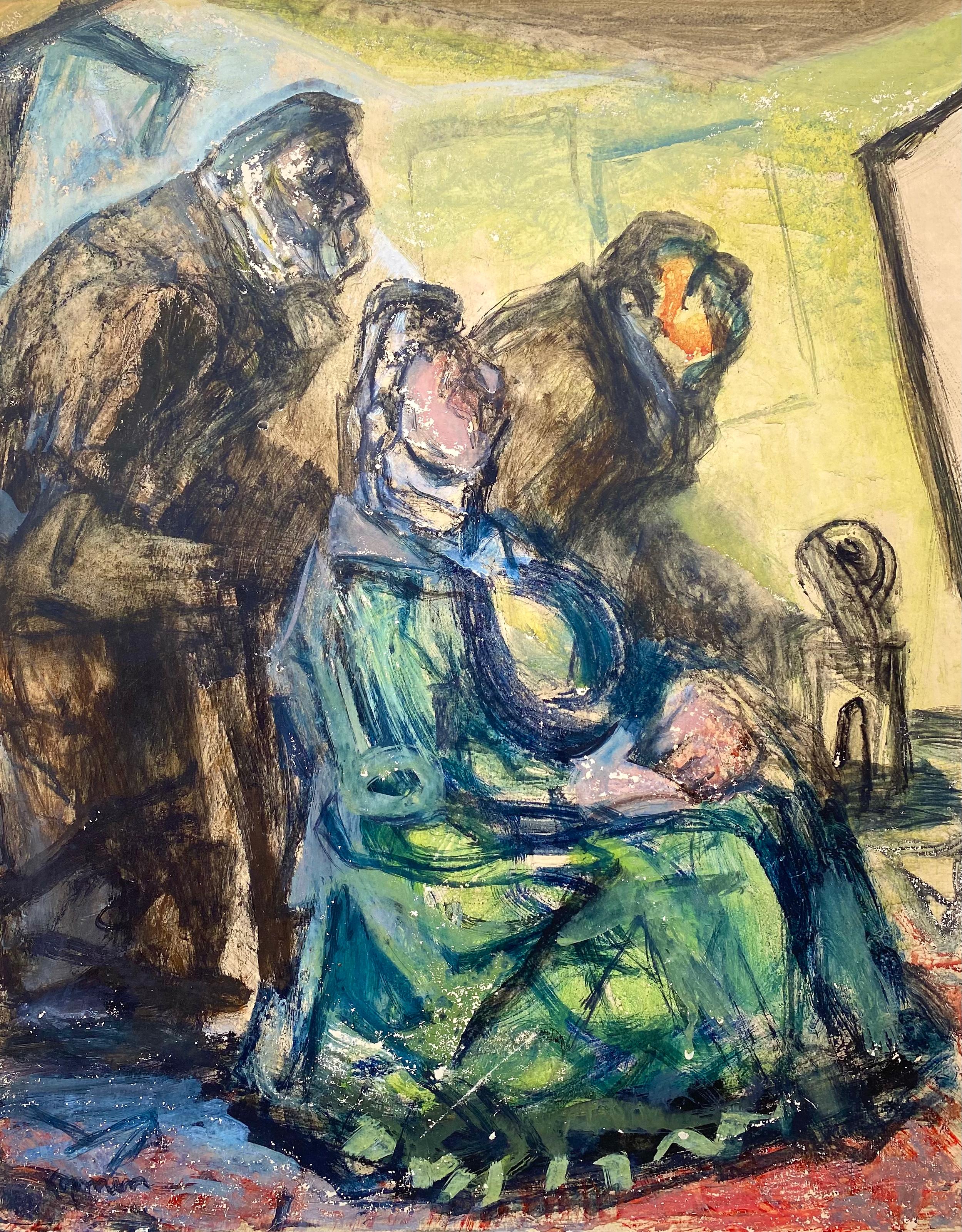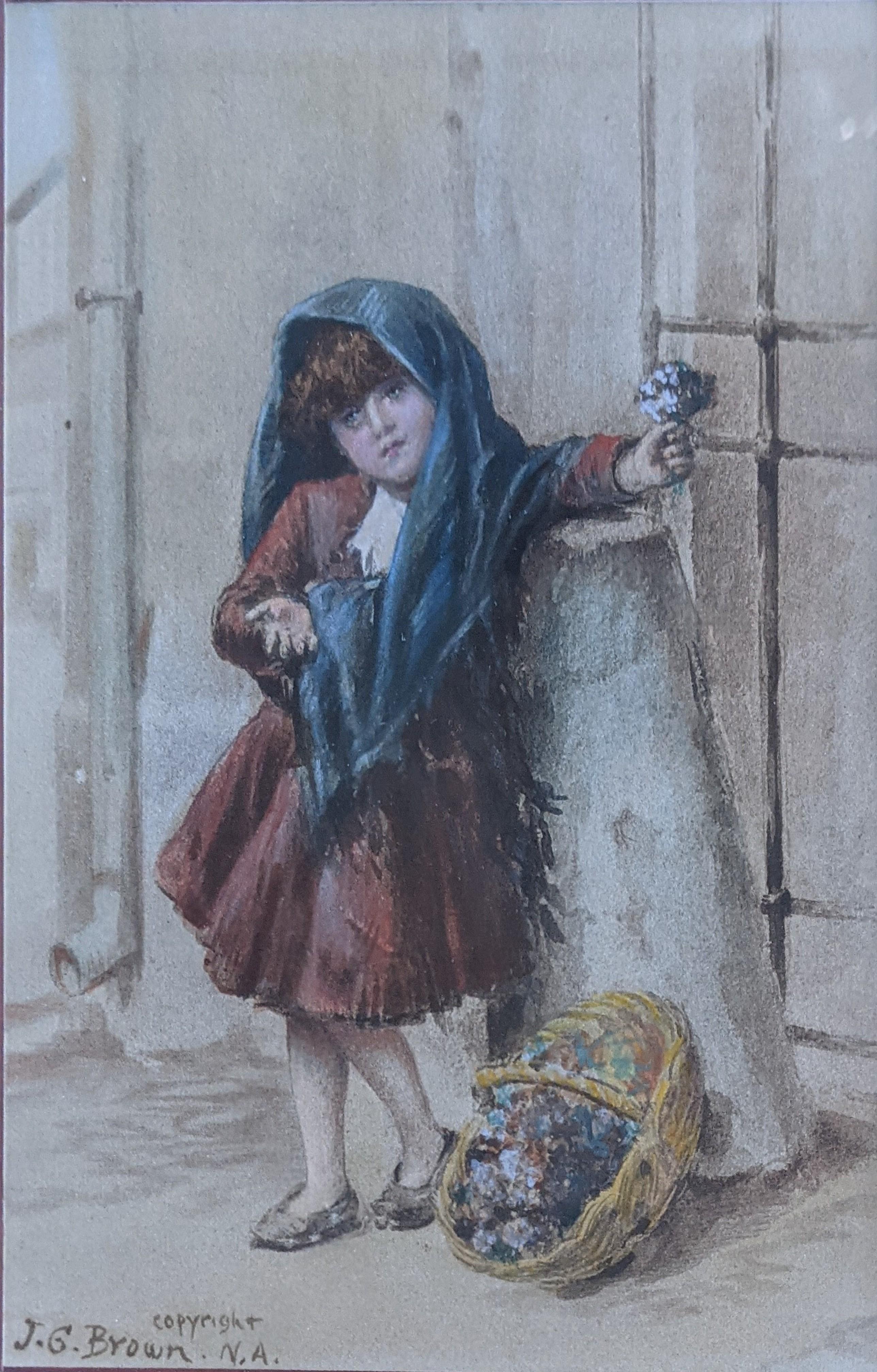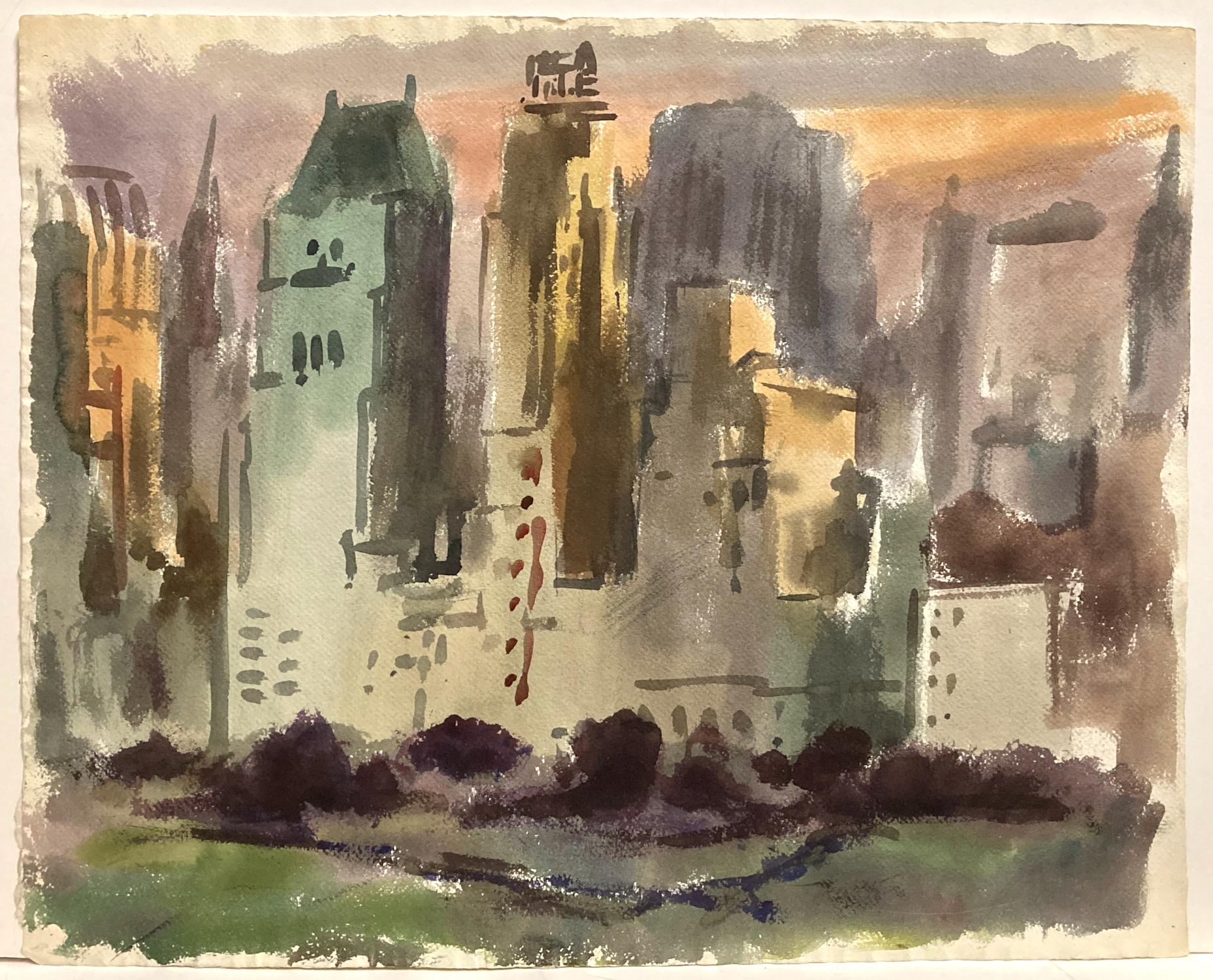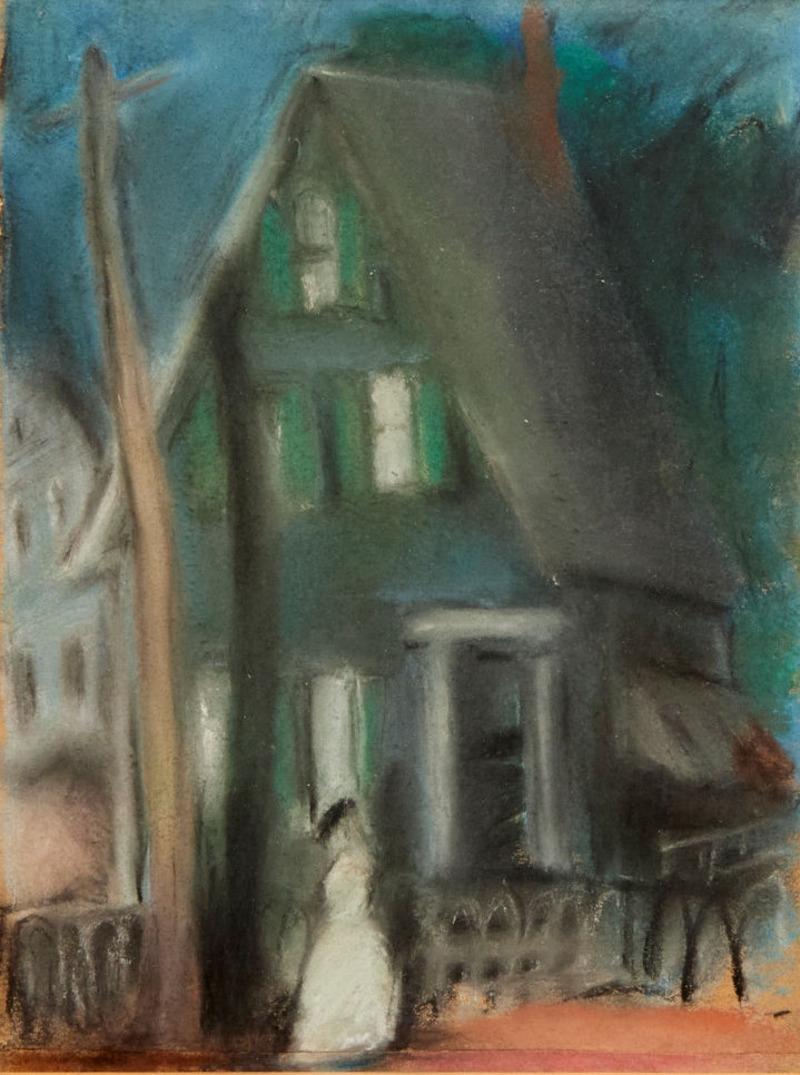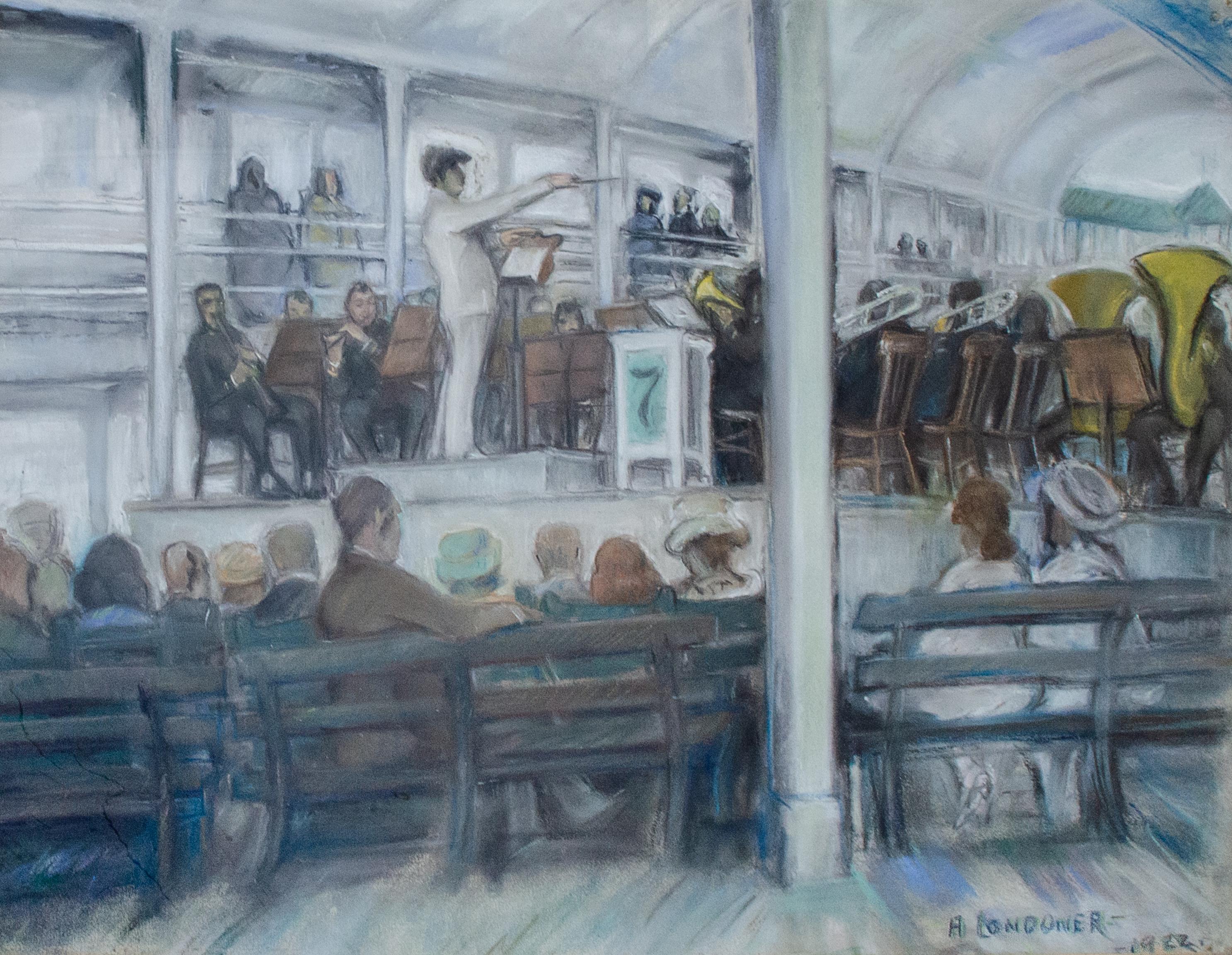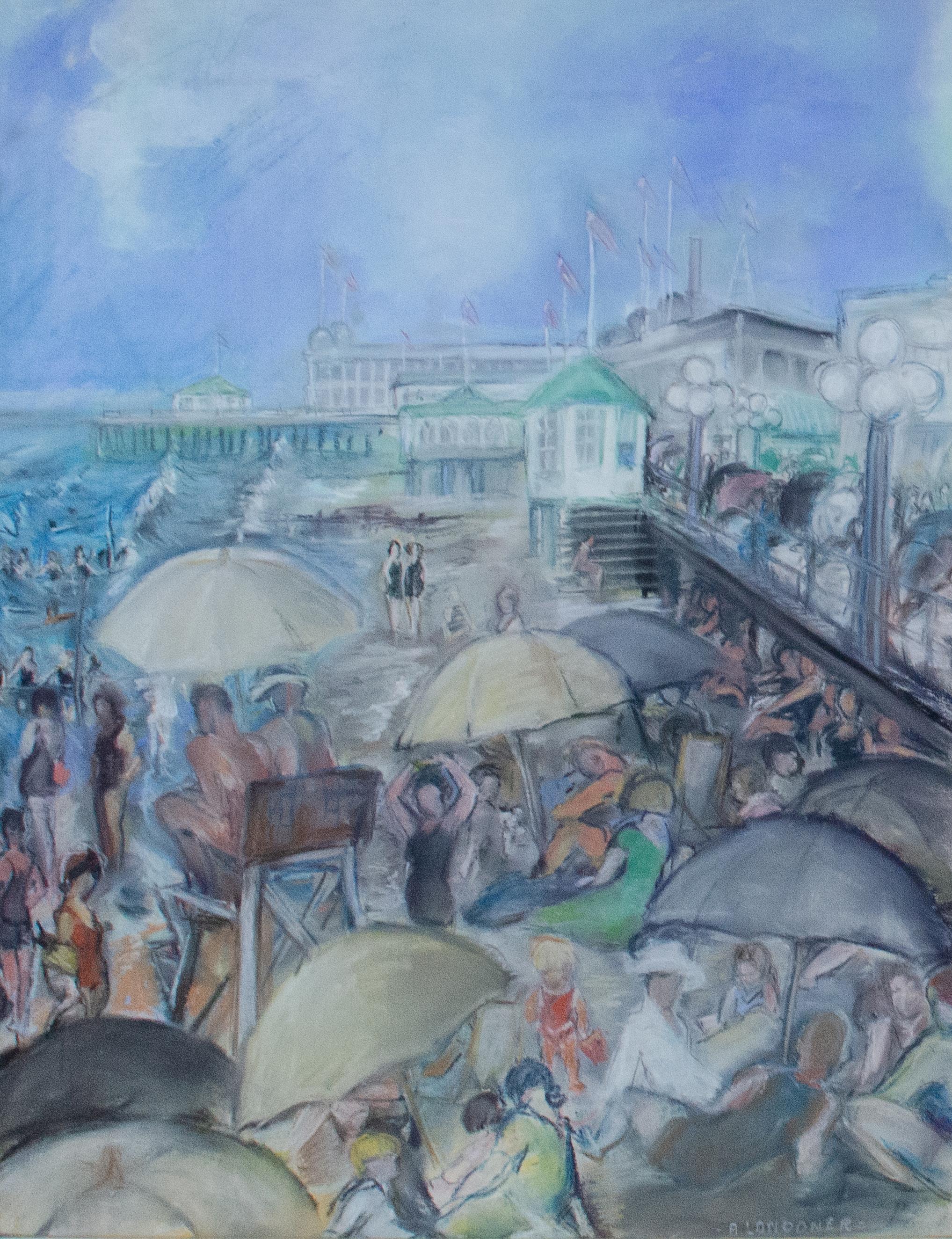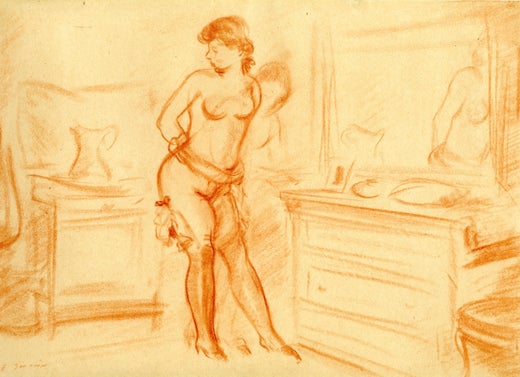Items Similar to "Reclining Nude" Everett Shinn, Figurative Woman Watercolor, Ashcan School
Want more images or videos?
Request additional images or videos from the seller
1 of 11
Everett Shinn"Reclining Nude" Everett Shinn, Figurative Woman Watercolor, Ashcan School1940
1940
About the Item
Everett Shinn
Reclining Nude, 1940
Signed and dated lower left
Watercolor on paper
4 1/2 x 9 inches
Provenance:
Christie's New York, Interiors, August 28, 2012, Lot 181
Private Collection
Everett Shinn, a future member of the Eight and remarkable, rather theatrical personality was born at Woodstown, New Jersey in 1873. Even more recent sources give 1876 as the year of Everett Shinn's birth but the artist usually lied about his age to appear younger than he actually was. Edith DeShazo claimed that information from family members established the date of November 6, 1876 as Shinn's birthday. But if this is true, he would have enrolled at the Spring Garden Institute in Philadelphia to study industrial art at the age of twelve. Born to a Quaker named Isaiah Conklin Shinn and Josephine Ransley Shinn, Everett was their third child. He enjoyed a happy childhood as an undisciplined boy fond of sweets, acrobatics, and the circus.
Shinn opted for the Pennsylvania Academy of the Fine Arts for instruction in the fall of 1893, and began as a staff artist for the Philadelphia Press. At that time William Glackens was working there as well, while John Sloan was at the Inquirer. A year later, Glackens was at the Press, and also, in 1894, George Luks joined the staff there. As DeShazo explained, "the Press art department became a meeting place for men both on the staff and off with similar artistic and literary interests." Members of the same group also met at Robert Henri's studio. By 1897, Shinn was in New York, working for the New York World where Luks had been for about a year. The rest of the "Philadelphia Four" would follow them before long.
Shinn spent much of 1898 hounding the offices of Harper's until finally, the editor and publisher, Colonel George Harvey saw his portfolio, then commissioned a view of the Old Metropolitan Opera House in a snowstorm. The pastel appeared about a year later in the February 17th issue of Harper's Weekly, in 1900. Meanwhile, Shinn kept busy with decorative work (murals, screens, and door panels) at private residences and even in Trenton, New Jersey's City Hall. In 1899, the Boussod-Valadon Galleries gave Shinn his first one-man show. He continued to carry out commissions for illustrations. Shinn began exhibiting at the Pennsylvania Academy (1899-1908) and at the Art Institute of Chicago (1903-43).
A trip to Europe is documented in 1900 by an exhibition at Goupil's in Paris and by various drawings of Paris and London but nothing more appears to be known about where Shinn went or what he saw, except that he was in Paris in July. Undoubtedly, he would have seen the art at the Paris Universal Exposition. DeShazo noted that after having returned to America, Shinn lost interest in lower class urban life, and Young pointed out that unlike most members of the Eight, Shinn was not attracted to art focused on "people sleeping under bridges." In fact, he loved the glamor of Uptown, fashionably dressed ladies, and above all, Shinn wanted to depict the excitement of the theater. He himself was an amateur playwright. Shinn used spatial devices that Degas had initiated earlier but as Young rightly observed, Jean-Louis Forain (1852-1931) is a more accurate source for Shinn's chic theatrical pieces, dancers, and cabaret scenes. Théophile Steinlen (1859-1901) was another artist popular with the Philadelphia artist-reporters group, as Ferber noted.
Shinn was not part of the National Arts Club exhibition of works by future members of the Eight in 1904, but he was mentioned by Gallatin in 1906 as a kind of American Degas. The author praised Shinn's draftsmanship and the technique of his pastels: "Very real they are: we might almost imagine ourselves looking in upon the actual scene." Shinn did take part in Macbeth Galleries' famous show four years later. He exhibited eight works, including The Hippodrome, London (Art Institute of Chicago), The White Ballet, ca. 1905, and The Orchestra Pit (both: collection of Mr. and Mrs. Arthur G. Altschul). One of his works sold, a painting now called Revue (Whitney Museum of American Art), formerly titled Girl in Blue. Shinn also participated in the Exhibition of Independent Artists in 1910 and finished the murals in Trenton in the following year. Milton Brown regarded these depictions by Shinn of pottery kilns and steel mills as "important . . . in that they treated a contemporary industrial subject rather than an historical or allegorical scene."
Shinn was invited but refused to exhibit in the 1913 Armory Show. In fact, at that time, he was working on neo-Rococo decorative panels in private residences. Not much has been written on Shinn's activities between 1920 and 1940. He did not exhibit often but continued to work as an illustrator. In the 1940s, Shinn was represented by Ferargil Galleries. He contributed "Recollections of The Eight," an essay in the Brooklyn Museum's catalogue of the exhibition The Eight, which opened on 24 November 1943. The rather monochromatic Washington Square (Addison Gallery of American Art) is a late work, from around 1945. Shinn, who died in New York City on May 1, 1953, managed to outlive all other members of the Eight. Unfortunately for us all, a thorough, scholarly monograph on the artist remains to be written. Shinn showed the impressionists' love of contemporary subject matter and painted in a spontaneous, non-academic manner. In fact, critics seem to agree that Shinn's facility was his downfall. On the other hand, he maintained visual and narrative clarity, as his penchant toward illustration prevailed.
- Creator:Everett Shinn (1876-1953, American)
- Creation Year:1940
- Dimensions:Height: 15 in (38.1 cm)Width: 19 in (48.26 cm)
- Medium:
- Movement & Style:
- Period:
- Condition:
- Gallery Location:New York, NY
- Reference Number:1stDibs: LU1841213461772
Everett Shinn
Everett Shinn, a future member of the Eight and remarkable, rather theatrical personality was born at Woodstown, New Jersey in 1873. Even more recent sources give 1876 as the year of Everett Shinn's birth (Zurier, Snyder, and Mecklenburg, 1995, p. 224) but the artist usually lied about his age to appear younger than he actually was. Edith DeShazo (1974, errata sheet) claimed that information from family members established the date of November 6, 1876 as Shinn's birthday. But if this is true, he would have enrolled at the Spring Garden Institute in Philadelphia to study industrial art at the age of twelve. Born to a Quaker named Isaiah Conklin Shinn and Josephine Ransley Shinn, Everett was their third child. He enjoyed a happy childhood as an undisciplined boy fond of sweets, acrobatics, and the circus (DeShazo, 1974, pp. 15-17). Shinn opted for the Pennsylvania Academy of the Fine Arts for instruction in the fall of 1893, and began as a staff artist for the Philadelphia Press. At that time William Glackens was working there as well, while John Sloan was at the Inquirer. A year later, Glackens was at the Press, and also, in 1894, George Luks joined the staff there. As DeShazo explained (1974, p. 29), "the Press art department became a meeting place for men both on the staff and off with similar artistic and literary interests." Members of the same group also met at Robert Henri's studio. By 1897, Shinn was in New York, working for the New York World where Luks had been for about a year. The rest of the "Philadelphia Four" (artist-reporters) would follow them before long. Shinn spent much of 1898 hounding the offices of Harper's until finally, the editor and publisher, Colonel George Harvey saw his portfolio, then commissioned a view of the Old Metropolitan Opera House in a snowstorm. The pastel appeared about a year later in the February 17th issue of Harper's Weekly, in 1900. Meanwhile, Shinn kept busy with decorative work (murals, screens, and door panels) at private residences and even in Trenton, New Jersey's City Hall. In 1899, the Boussod-Valadon Galleries gave Shinn his first one-man show. He continued to carry out commissions for illustrations (see Bullard, 1968). Shinn began exhibiting at the Pennsylvania Academy (1899-1908) and at the Art Institute of Chicago (1903-43).
About the Seller
5.0
Platinum Seller
These expertly vetted sellers are 1stDibs' most experienced sellers and are rated highest by our customers.
Established in 2021
1stDibs seller since 2022
63 sales on 1stDibs
Typical response time: <1 hour
- ShippingRetrieving quote...Ships From: New York, NY
- Return PolicyA return for this item may be initiated within 3 days of delivery.
More From This SellerView All
- "Flower Girl, " John George Brown, Genre Painting, Street FigureBy John George BrownLocated in New York, NYJohn George Brown (1831 - 1913) Flower Girl, circa 1900 Watercolor on paper 6 3/4 x 4 3/4 inches Signed lower left Period Hand Carved Foster Brothers Fram...Category
Early 1900s Ashcan School Figurative Paintings
MaterialsPaper, Watercolor
- "Night Stroll" Amy Londoner, Ashcan School, Figurative NocturneBy Amy LondonerLocated in New York, NYAmy Londoner Beach at Atlantic City, circa 1922 Signed lower right Pastel on paper Sight 23 x 18 inches Amy Londoner (April 12, 1875 – 1951) was an American painter who exhibited at...Category
1910s Ashcan School Figurative Paintings
MaterialsPastel, Paper
- "Musical Conductor" Amy Londoner, Ashcan School, Figurative Concert SceneBy Amy LondonerLocated in New York, NYAmy Londoner Musical Conductor, 1922 Signed and dated lower right Pastel on paper Sight 18 x 23 inches Amy Londoner (April 12, 1875 – 1951) was an American painter who exhibited at ...Category
1920s Ashcan School Figurative Paintings
MaterialsPastel, Paper
- "Beach at Atlantic City, New Jersey" Amy Londoner, Ashcan School, FigurativeBy Amy LondonerLocated in New York, NYAmy Londoner Beach at Atlantic City, circa 1922 Signed lower right Pastel on paper Sight 23 x 18 inches Amy Londoner (April 12, 1875 – 1951) was an American painter who exhibited at...Category
1920s Ashcan School Figurative Paintings
MaterialsPastel, Paper
- "In Foreign Parts" Eugene Higgins, Southwestern Pueblo, Modern FigurativeBy Eugene HigginsLocated in New York, NYEugene Higgins In Foreign Parts, circa 1913 Signed lower right Watercolor on paper Sight 17 x 13 inches Born William Victor Higgins in 1884 to a Shelbyville, Indiana farm family where the only art Victor was aware of as a child was his father's love of flowers. "He loved their forms and their colors, and he tended his garden as a painter might work a canvas." At the age of nine, Victor met a young artist who traveled the Indiana countryside painting advertisements on the sides of barns. He purchased paints and brushes so the young Higgins could practice his own artwork on the inside of his father's barn. He also taught Victor about art museums and especially about the new Chicago Art Institute. This information never left the young artist, and he saved his allowance until his father allowed him at the age of fifteen to attend Chicago Art Institute. He worked a variety of jobs to finance his studies both there and at the Academy of Fine Arts. Victor Higgins traveled to New York in 1908, where he met Robert Henri, who became a significant influence by depicting every-day scenes and stressing the importance of the spirit and sense of place as important factors in painting. Higgins was also greatly affected by the New York Armory Modernism Show of Marsden Hartley in 1913. While Victor Higgins was in Chicago he met former mayor and avid collector Carter H. Harrison who was to prove instrumental in the growth of Higgins career for several years. Harrison agreed to support Higgins for four years to go to Paris and Munich and paint and study in the great museums in Europe. While at the Academie de la Grande Chaumier in Paris (1910-1914) he met Walter Ufer, who was another Chicago artist being sponsored by Carter Harrison. This meeting was not only a life-long friendship, but the beginning of a great change in the way Higgins looked at "American" art. He decided that America needed it's own authentic style rather than the 19th Century classic style he was taught in Europe. Very soon after returning to Chicago in 1914, Harrison sent him and Walter Ufer on a painting trip to Taos, New Mexico for a year in exchange for paintings. Higgins made other similar agreements and was able to support himself with his painting. This trip was a life-changing experience and introduced Higgins to the authentic America he had been looking for. In 1914 Taos was an isolated village about twelve hours from Santa Fe on an impossible dirt road. But the colorful life of the pueblo people and the natural beauty drew a collection of artists who became the Taos art colony, from which the Taos Society of Artists was founded in 1915. Victor Higgins became a permanent resident within a year of his arrival and a member of the society in 1917, exhibiting with Jane Peterson in 1925 and with Wayman Adams and Janet Scudder in 1927. The members would travel around the country introducing the Southwest scenes with great success. He remained a member until the Society's dissolution in 1927. Higgins was the youngest member of the group of seven. Other members were Joseph Henry Sharp, Bert Phillips...Category
1910s American Modern Figurative Drawings and Watercolors
MaterialsWatercolor, Paper
- "Portrait of an Italian Fencer, " John Frederick Kensett, Hudson River SchoolBy John Frederick KensettLocated in New York, NYJohn Frederick Kensett (1816 - 1872) Portrait of an Italian Fencer, circa 1845-47 Watercolor on wove paper 13 1/8 x 8 1/8 inches Signed with initials and inscribed lower right "J.F.K. Rome" From October 1845 through the spring of 1847, Kensett lived in Rome. He attended classes where he sketched from live models, and he sketched in the countryside outside Rome and around Florence, Perugia, and Venice, places he visited with his artist friends. He fulfilled commissions for paintings from Americans in Italy, and by 1847 his career was well established. Son of an English immigrant engraver, John Kensett lacked enthusiasm for that medium and became one of the most accomplished painters of the second generation of Hudson River School painters. His reputation is for Luminism, careful depiction of light, weather, and atmosphere as they affect color and texture of natural forms. He was particularly influenced by the painting of Asher Durand in that he focused on realism and detail rather than the highly dramatic views associated with Thomas Cole. Going to the western United States in the mid 1850s and the 1860s, he was the first of the Hudson River School painters to explore and paint the West. Kensett was born and raised in Cheshire, Connecticut, and learned his engraving from his father, Thomas Kensett with whom he worked in New Haven, Connecticut until 1829. He continued working until 1840 as an engraver of labels, banknotes and maps and was employed part of that time by the American Bank Note Company in New York City. There he met Thomas Rossiter, John Casilear, and other artists who urged him to pursue painting. In 1840, he and Rossiter, Asher Durand, and Casilear went to Europe where Kensett stayed for seven years and supported himself by doing engraving but became accomplished in landscape painting. Having sent canvases of Italian landscapes back to New York, he had a reputation for skillful painting that preceded him. When he returned to New York City in 1847, he was an "instant success" and very sought after by collectors. Two of his Italian landscapes had already been purchased by the American Art Union. By 1849, he was a full member of the National Academy of Design and was generally popular among his peers. His studio was a gathering place with travelers stopping by to see his canvases and to identify "precise locations in the Catskills or Newport or New England in the oil sketches and drawings that covered his walls." (Zellman 170). For the women, he was a popular bachelor, "romantic looking with high forehead and sensitive expression." (Samuels 262) He was also sought after by many organizations. Among his activities were serving on the committee to oversee the decoration of the United States Capitol in Washington DC, and becoming one of the founders of the Metropolitan Museum in New York. An inveterate traveler, Kensett spent summers on painting excursions away from New York City. One of these trips was a special painting excursion with fifteen other artists sponsored by the B & O Railroad from Baltimore, Maryland to Wheeling, West Virginia. Unlike many of the Hudson River painters...Category
1840s Hudson River School Figurative Paintings
MaterialsWatercolor, Paper
You May Also Like
- ”Admiring the Picture”By Benjamin KopmanLocated in Southampton, NYVery well executed original gouache on archival paper by the well known American artist Benjamin Kopman. The scene depicts three figures admiring a picture. Signed lower left. Circa ...Category
1930s Ashcan School Figurative Drawings and Watercolors
MaterialsGouache, Archival Paper
- James Penney, New York From Central ParkBy James PenneyLocated in New York, NYJames Penney was widely known for his New Yorker covers as well as his paintings and prints. Penney was from Saint Joseph, Missouri. He trained i...Category
Mid-20th Century Ashcan School Landscape Drawings and Watercolors
MaterialsWatercolor
- Third Man 2, black and white, night scene, cityscapeBy Tom BennettLocated in Brooklyn, NYDramatic imagery from FILM NOIR series of black and white monotypes, blending surreal mindscapes with stark realism About Tom Bennett: With quick brushstrokes, Tom Bennett creates r...Category
2010s Ashcan School Figurative Drawings and Watercolors
MaterialsMonotype, Archival Paper
- Head Study, 1930By John SloanLocated in Missouri, MOHead Study, 1930 John Sloan (1871-1951) Signed Lower Right 10.5" x 9" Unframed 19" x 16.5" Framed Born in Lock Haven, Pennsylvania, John Sloan became one o...Category
Early 20th Century Ashcan School Portrait Drawings and Watercolors
MaterialsConté, Paper
- A Pair of Framed Monkey StudiesBy Alexander Oscar LevyLocated in Buffalo, NYA pair of exquisite drawings by American Ashcan School artist Alexander Oscar Levy.Category
1920s Ashcan School Animal Drawings and Watercolors
MaterialsGraphite, Archival Paper
- Otis Skinner as Col. Philippe Bridau in "The Honor of the Family"By George Benjamin LuksLocated in Concord, MAGEORGE LUKS (1867-1933) Otis Skinner as Col. Philippe Bridau in "The Honor of the Family", c. 1919 Charcoal on paper 12 x 7 ¾ inches (sight) Signed at lo...Category
1910s Ashcan School Figurative Drawings and Watercolors
MaterialsPaper, Charcoal
